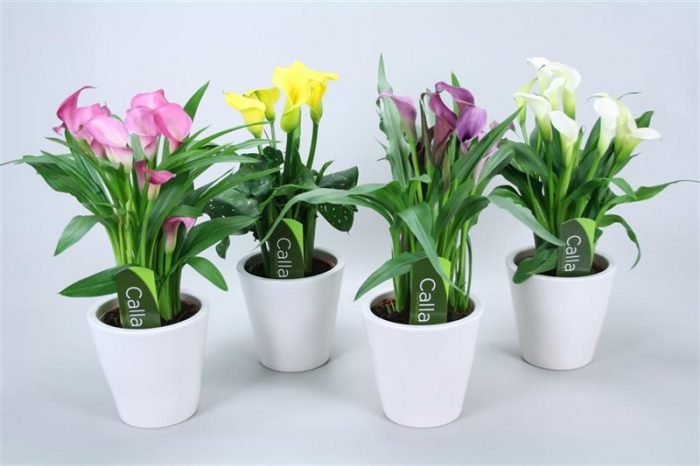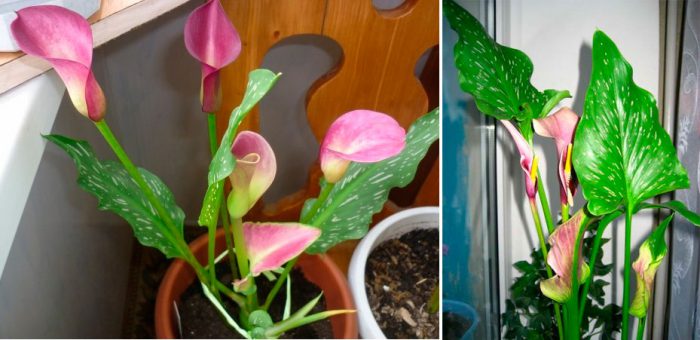Zantedeschia very often also called calla or calla lily, and it belongs to the aroid family. This genus of plants has few species, so in the literature no more than 6 descriptions can be found. There are species belonging to the separate genus Calla. The varieties found in floriculture come from various natural species, and therefore they cannot be strictly qualified.
Tuberous calla lilies are perennials. Such a plant simply adores moisture. In the wild, it is found in South Africa and most often grows near water bodies or in swampy areas. Often the root and some of the shoots are in the water.
Calla leaflets are heart-shaped and are located on very long petioles and are quite large. Their color is either green or variegated, while the spots are cream or white. Shoots of zantedeschia are erect. There is also a branched and powerful root. The varieties descended from the Ethiopian Zantedeschia (Zantedeschia aethiopica) have a branched rhizome. And those that descended from Zantedeschia elliottiana have tubers.
The inflorescence has the shape of an ear, the cover of which is approximately 15 centimeters long. It comes in yellow, pink, white, cream, purple, and it depends entirely on the variety. There are varieties, the bedspreads of which are painted in 2 different colors at once, as well as with a smooth transition of shades of the same color. As a rule, the outer cover is colored more intensely than the inside. It blooms for a very long time - from autumn to spring months.
Those varieties that originated from the zantedeschia elliot must necessarily be provided with a full dormant period, since the success of flowering depends on this. The duration of this period is approximately 2 months and. as a rule, it is better for him to choose the summer months (like wild flowers), but any others are possible.
Content
Calla lily care at home
Illumination
This is a fairly light-loving plant, and it needs a lot of light in both warm and cold seasons. However, it can get used to any light and grow and develop quite normally. When growing on the southern ocean in the summer, the flower may undergo overdrying, which negatively affects its condition.
Temperature regime
Calla loves warmth very much and for its normal growth and development it is necessary that the air temperature in the room is at least 18 degrees, and best of all, if it is, from 22 to 25 degrees. Protect the plant from sudden temperature fluctuations and drafts.
Humidity
The plant feels great in high humidity, so you need to spray it as often as possible, and also wash the leaves. But despite the fact that it is moisture-loving, calla can easily adapt to normal room humidity. However, the most beautiful and strong flowers grow in high humidity conditions.
How to water
Since this plant prefers to grow in the wild in swampy areas, it simply needs abundant watering in the warm season. After the dormant period begins, it should be watered sparingly. It is recommended to water the flower with soft, warm water (or room temperature).
Top dressing
Zantedeschia is fed from February to June. When it begins to actively grow and bloom, a special fertilizer for flowering indoor plants is used for feeding. If there is a lot of nitrogen in the fertilizer, this will provoke active foliage growth.
Basic transplant rules
You need to transplant calla lilies in a fairly spacious flower pot. It needs to be filled with a nutrient substrate. Don't forget a good drainage layer. It is necessary to carry out the transplanting procedure every year, because this plant greatly depletes the earth. It is necessary to deepen the tuber by 5-10 centimeters (depending on the size of the tuber itself). Often acquiring tubers it is very difficult to understand where the upper part is and where the lower part is. In this case, it is recommended to treat it with a growth-promoting drug and place it in a warm, dark place. After a few days, it will be enough to check where the shoots are growing from.
Earth mix
The soil mixture can be used purchased for aroids. you can do it yourself. To do this, mix humus (or compost), turf and leafy soil, as well as sand and peat in a 1: 2: 1: 1: 1 ratio.
Bloom
The first flowering of a plant occurs at the age of 2 years. At the same time, the first flowers that appear on the calla have a rather pale color, sometimes even greenish. Colors become more vivid over time. This plant blooms for a very long time for many months. For a plant to bloom well, it needs a dormant period. If it has enough light, then flowering begins at the end of the autumn period and lasts all winter. After 2 or 3 years, the zantedeschia needs to be rejuvenated, as it grows. Rejuvenate it by dividing the rhizome and seating.
Dormant period
The dormant period begins at the end of flowering. As a rule, calla lilies bloom in winter, but if there is little light and heat, then it blooms in the spring. When the flowering is over, the aerial part of the flower will dry out, while watering must be reduced (practically stopping it). In July, the remaining leaves are removed from the plant, dried in air, and then transplanted using fresh earth mixture. Watering is resumed gradually. New leaves begin to grow in the fall. The rest period is approximately 6 weeks.
In the wild, calla lilies have a dormant period in summer (when it is dry and hot). When grown at home, this period falls on the winter, because due to the small amount of light, the development of the plant stops. But in the spring and in the not very hot summer months, this flower feels great. Currently, zantedeskia has begun to grow as a garden flower, and for wintering it is dug up and placed in a cellar.
How to propagate
Propagated by dividing the rhizome. During transplantation (after a dormant period), the side shoots are disconnected from the mother, and planted in separate pots, which should be wide and low.
Diseases
Can settle spider mite, because the plant must be systematically moistened.


















And my callas bloom in summer, rest in winter. And bloom in the first year after planting.
And they gave me blooming calla lilies on March 8, but her flowers almost immediately dried up, and the leaves also began to dry, fearing that she would die, I transplanted into a more spacious pot, but there was no tuber, there was such an interlacing of roots, that I did not divide anything, but planted it entirely, the leaves stopped bending, I water abundantly, but after reading the article, I realized that I did everything wrong. What do you think, stop watering and give her a dormant period, although four months have already passed in time?
and to plant already in the next year
And this morning on the leaves and on the tips of the flowers, droplets appeared for me to rain?
I bought a couple of calla lilies. It was already in the fall, I decided to do it in the spring. Now the leaves on both have dried up. Is this the way it should be? I water as the earth dries up.
My whole flower dried up back in June. The pot of earth stood. Before ng I wanted to throw it out, and from it they poured about 6 pieces at once. I don't know what to do with him. I don't know how to take care of flowers. And this one was presented. Please tell me how to get it out?
Love flowers, water, spray the leaves, they will thank you.
I bought a flower in May, immediately transplanted it ... after a month the flowers fell off. I water as the soil dries up, but recently I saw spots on the leaves, what should I do ???
Stands on the window, not in a dark corner